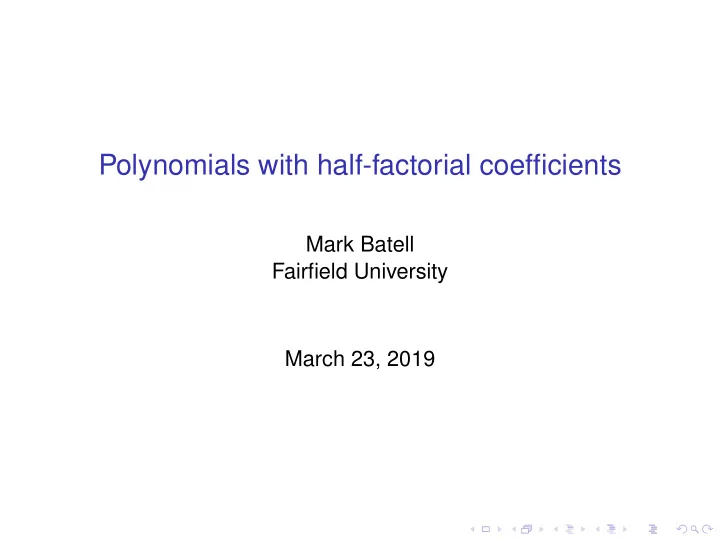

Polynomials with half-factorial coefficients Mark Batell Fairfield University March 23, 2019
Definition. An integral domain R is half-factorial if R is atomic and m = n whenever α 1 α 2 · · · α n = β 1 β 2 · · · β m and the α ’s and β ’s are irreducible elements (atoms) of R .
Gauss’s Lemma Q [ x ] Z [ x ] Figure: Venn diagram illustrating the containment of polynomial rings Z [ x ] ⊆ Q [ x ] . Gauss used the fact that Q [ x ] is factorial to prove that Z [ x ] is also factorial.
Gauss’ Lemma Part I The product of two primitive polynomials over Z is primitive. Gauss’ Lemma Part II Every irreducible polynomial f ∈ Z [ x ] of degree � 1 is irreducible in Q [ x ] . Theorem (Gauss) The polynomial ring Z [ x ] is factorial. Question: Under what conditions is a polynomial ring R [ x ] half-factorial? Theorem (Zaks) Let R be a Krull domain with class group G . Then the polynomial ring R [ x ] is half-factorial if and only if | G | � 2.
Sufficient Conditions Theorem. Consider the following conditions on a domain R : a) R is integrally closed b) If f , g ∈ R [ x ] and fg is primitive, then f is superprimitive or g is superprimitive c) If f , g are primitive polynomials over R and a ∈ R is a constant factor of the product fg , then ℓ ( a ) � 1 d) If I is a primitive ideal and r s ∈ I − 1 , then there is a common divisor g of r and s such that ℓ ( s g ) � 1. If R is an atomic domain satisfying all of the above, then R [ x ] is an HFD.
Euclid’s Lemma: In a factorial domain, if ab = cd where a and c are relatively prime, then a divides d . A Generalization: Let us say that R has the Z-property if whenever abc = de (where the elements are all nonzero nonunits), then either ab and d are not relatively prime or ab and e are not relatively prime.
Example. The Krull domain R := F [ x , y , zx , zy ] does not have the Z-property: ( x )( x )( zy )( zy ) = ( zx )( zx )( y )( y )
Integral Closures Theorem (Mori, Nagata) The integral closure of a Noetherian domain is a Krull domain. Theorem (Barucci) The complete integral closure of an integrally closed Mori domain is a Krull domain.
Example. The Mori domain R := Z + x 6 Z [ x ] does not have the Z-property: ( 2 )( 3 )( 6 x 2 ) = ( 6 x )( 6 x )
Theorem: If the polynomial ring R [ x ] is half-factorial, then R has the Z-property. Theorem: Let R be atomic. If R has the Z-property, then R is half-factorial.
Characterization of half-factorial polynomial rings Theorem: Assume R is a domain in which every v -finite v -ideal is v -generated by two elements. Then R [ x ] is an HFD if and only if each of the following conditions is satisfied: (1) R is integrally closed, (2) R has the Z-property, and (3) ( AB ) − 1 = { uv | u ∈ A − 1 , v ∈ B − 1 } if A , B ⊆ R are finitely generated ideals whose product AB is primitive.
The two-generator problem for ideals Theorem (Matlis). Let R be a Noetherian integral domain. Then every ideal is generated by two elements if and only if (1) R is a one-dimensional Gorenstein ring, and (2) M is projective or M − 1 is a one-dimensional Gorenstein ring for each maximal ideal M of R . Open Problem: Generalize this result to v -ideals.
Example. In F [[ x 3 , x 5 ]] , consider the ideal I = M 2 = ( x 6 , x 8 , x 10 ) Is it v -generated by two elements? The following calculations suggest otherwise: 1 / x 3 ∈ ( x 6 , x 8 ) − 1 1 / x ∈ ( x 6 , x 10 ) − 1 1 / x 2 ∈ ( x 8 , x 10 ) − 1 1 / x − 1 / x 3 ∈ ( x 6 , x 8 + x 10 ) − 1
Theorem. Let R be a Krull domain. Then R has the Z-property if and only if R is half-factorial and for each primitive ideal I ⊆ R there exists an irreducible element α such that α ∈ I v . An Application. The Krull domain R := Q [ x , y , zx , zy ] is not half-factorial: � x 2 + y 2 � � x 2 + z 2 x 2 � = x 2 ( x 2 + y 2 + z 2 x 2 + z 2 y 2 )
Lemma. Assume R is a Krull domain with nontorsion class group. Then there exists a nontorsion prime P and an irreducible element x ∈ P such that x 2 factors uniquely. Theorem. Let R be a Krull domain. If R has the Z-property, then its class group is torsion.
Recommend
More recommend